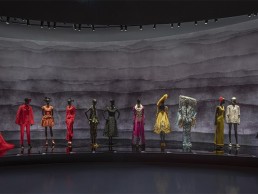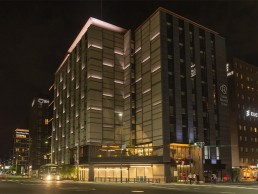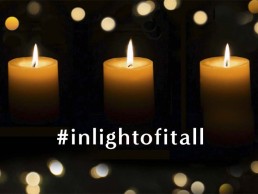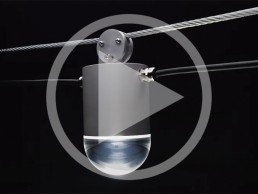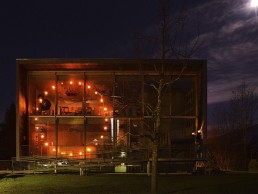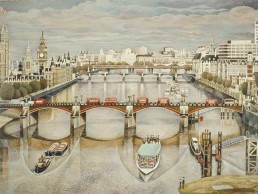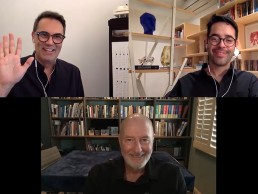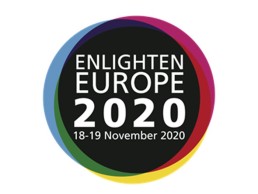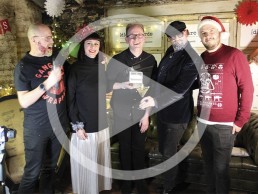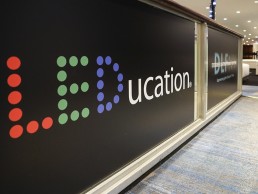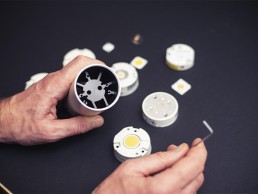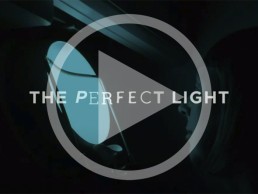Christian Dior: Designer of Dreams, China
The turn of events the world has experienced this year has undoubtedly had an impact on everyone, globally. But from it, we have witnessed an increasingly staggering positive response from industry creatives, and the new lighting design scheme for the Christian Dior Designer of Dreams exhibition in Shanghai by Lightemotion is no exception, with its unique Zoom-based installation.
Beginning its journey back in 2017, the Christian Dior Designer of Dreams exhibition launched at the Musée des Arts Décoratifs of Paris before moving on to London’s Victoria & Albert Museum, and arriving at Shanghai’s Long Museum West Bund in 2020.
Canadian-based lighting firm Lightemotion was assigned the brief of illuminating the display by Nathalie Crinière in Paris, who designed the exhibit, which comprises more than 270 Haute Couture silhouettes alongside original documents, accessories and artworks by contemporary Chinese artists. A complex and dynamic lighting scheme was created to interact with and highlight the pieces in a sculptural aesthetic for what was the first big international exhibit put together after the Coronavirus was declared a global pandemic in March. As such, the designers embarked on a unique and ground-breaking approach to the task by establishing an entirely remote team to implement the scheme.
Professional camera operators helped to facilitate an accurate portrayal of each room, from their colours and tones to the size of each space. A number of cameras were also installed on tripods to give the team simultaneous virtual views of each room from various angles. At the same time, more cameras set at eye level moved through the rooms and around specific items that needed to be lit to complete the full picture for the designers, giving them a chance to understand the overall visitor experience and each item’s setting in the rooms.
Crinière, curator Oriole Cullen and the Dior teams had worked on the project for months leading up to its arrival in China, which made it possible for a smooth transition to working remotely on the lighting install. The process of the installation started with the placement of the dresses in the rooms, and it was only when the placement of each exhibited item with the remote teams by Cullen was finalised that the lighting process started.
Lightemotion was then connected to local staff, Crinière, the Dior team, Cullen, and audiovisual designer La Méduse via a Zoom link, which was left open at designated times for all members to access. The virtual meeting room was specifically for the usage of the lighting design team; however, it proved a useful tool for all parties to participate in consultations and voicing their opinions cohesively.
The open link – typically open for up to 12 hours a day – made it possible for the Lightemotion team to consult directly with the necessary people when making critical decisions - when lighting a specific dress, for example. The team could witness multiple lighting options and scenes that would highlight varying aspects of the dress and decide together on the most fitting outcome.
Francois Roupinian, President and Director of Design at Lightemotion, reflects on the collaboration with Crinière and the formation of the successful project: “It has been an amazing collaboration with Nathalie and her team, curator Oriole Cullen, and with the Video artist team La Méduse. From the beginning, we were able to sit with everyone and bring fresh new lighting ideas to really create that sensory experience. Nathalie also wanted to be able to tell the story of the show with light and wanted us to be able to create a subtle environment that would serve the purpose and the experience of the show.
“The concept was to create a sensory experience with light that would evolve throughout the show. I wanted to put the artefacts on stage and illuminate them in a way where they could tell a story and create a feeling, an experience that the visitors feel when they see the display. Also, the environment of each of these spaces was crucial; we went into detail to make sure that even the general lighting would fit with each theme and that the public always had a sense of being submerged and part of the environment. It is a very submersible experience,” he said.
“What unified the show was the extreme quality of the lighting and how it would sculpt the objects. Each artefact was treated as a star, as a personage.”
Understanding from the outset that communication was key to making this project a success, Roupinian saw the project as an opportunity to create a platform for everyone to be directly involved, like pieces of the puzzle coming together. “The challenge became a new way of working for us. I established from the get-go a level of communication where everybody would be involved and be part of the process. The client, the House of Dior, the exhibit design team, the auiovisual designers, and the installers were always invited to join us, to pop up in our Zoom sessions. So, these sessions became the pivotal point for everyone, and we were able to get some amazing human interaction. I do not believe in working solo and for me, 90% of a project is the human factor. Everyone felt part of the process and it made the artistic elaboration quite unique and collaborative.
“Our team in Shanghai was incredible. They were our eyes on the ground and we could not have reached the level of quality without them. They were engaged and generous; the local team is a major part of the lighting success of this project.
“The person in charge of cultural projects at Dior was involved almost every day in the Zoom sessions. We would ask her to pop in for a few minutes, ask her feelings and her level of comfort on how we were presenting the pieces, which was very different from what they had done in the past,” he added. “I think the key was to always stay connected with the curator and the Dior teams and be sensitive to their needs and business objectives, and be flexible and adapt what we were doing to the challenges they may encounter during the setup. Good lighting design is a process where you need to be generous - it has to be heart driven and not ego driven - we must never forget that we are the magic wand that is meant to serve a purpose, the exhibition’s purpose, not ours.”
When speaking to arc about the difficulties the project encountered, surprisingly the list was very short. With the on-ground support of the Activation team and the constant level of communication, the Lightemotion scheme was installed successfully and with minimal difficulty. One of the only unfortunate consequences, as a result of the global Covid-19 situation, was the team having difficulty sourcing the desired fittings for the installation. As such, many fixtures were replaced with more convenient local alternatives to combat this obstacle.
Another matter they had to address during the installation was the lack of track or support system for fixtures in the museum. Roupinian explained further: “We had to create an extensive study and layout of additional tracks and pointing structure to host the lighting needed for the project. Also wanting to use DMX, we had to come up with different scenarios, from wired DMX, to wireless DMX systems.
“Also, part our design was to take advantage of the beautiful brutalist architecture of the space by illuminating it and making it part of the background of the show. So, cable placement was critical; we did not want to have a busy ceiling. Furthermore, La Méduse created an elaborate, immersive video mapping environment, so it was important to have minimal intervention in some areas so the video could take full advantage of the surfaces.”
Reflecting on the successful installation, Roupinian added: “I feel the lighting brings a subtle aura throughout the show and embraces the visitors from the different spaces - we say in French “le fil conducteur”, which means it is like the connecting thread of the project. For Dior, a major difference was the way the dresses were lit up. I used a very sculptural approach with the lighting, we never used just a general wash of light. This technique made the dresses pop and it brought emotions. It was not just about creating beautiful environments but bringing that special attention to each piece so the visitor could really connect with them and feel something, maybe an emotion that the creator had when he designed that dress.”
Moving forward, Lightemotion is now undertaking numerous projects utilising its remote experience over Zoom, and is due to deliver a Magic exhibit in Toulouse, France this December, as well as a major show in Singapore and in Canada, an architectural project at Parliament Hill in Ottawa, all created remotely.
“We have developed a level of connectivity working remotely that does not affect or reduce the quality of the projects. In the way we produce our brief / mood boards and our narrative, we are able to give enough information so that the team on site feel well-equipped. We are present every day via Zoom. I see a major market opening up for us; we already have a very extensive experience and portfolio of international projects, and now our clients and future ones can see that we can deliver the same quality even remotely. That is a major selling point as it dramatically reduces costs,” concluded Roupinian.
Daiwa Roynet Hotels, Japan
In lighting design, the old adage goes that no two projects are the same; that each has its own requirements, its own concepts and its own unique end result.
This was particularly apparent for Akari-Lisa Ishii, Director of I.C.O.N. who has designed the façade lighting for three branches of the Daiwa Roynet Hotel chain across Japan. For these hotels, rather than create a uniform scheme across all sites that would become synonymous with the Daiwa Roynet brand, she instead drew inspiration from each hotel’s context – whether this is geographical, historical, cultural, architectural or temporal context – to create something unique to its location.
The notion of context is something that Ishii believes is integral to effective lighting design, in order to avoid cityscapes from becoming repetitive and boring. “Being bright or colourful is not a problem itself if it is an appropriate concept based on contextual research,” she said. “When you ignore the context, you end up with a similarity all over the world. I love the exciting, dynamic lighting in Times Square, in Shibuya, but if you only have this, it is going to be very boring. So I warn myself not to repeat the same thing everywhere in the world.”
The first hotel that Ishii was asked to illuminate was in Ariake, Tokyo. I.C.O.N. was appointed as the lighting consultant for the hotel by architect Azusa Sekkei, who has worked regularly with the Daiwa Roynet hotel group. “At the first presentation to the client, their president admitted that he always thought lighting was one of the key issues to create a hotel’s image, but he did not know how. Since that day, our close collaboration started, and the journey continues to this day,” Ishii explained.
The Ariake hotel is situated in a new district currently under development in the Tokyo Bay Area – a district that was intended to be one of the core sites for the 2020 Olympic Games (now rescheduled to 2021). The hotel, which is adjoined to a shopping centre, is also at the crossing point of two major railway stations, with a public concourse connecting the two stations. The exterior lighting therefore needed to signify the nocturnal identity of both the hotel and the area, while providing a visual connection between the stations in a unique and interesting way.
“The architectural context is always very important, and the architect came up with an interesting crossing notion of horizontal and vertical design,” Ishii explained. “The lighting design concept that I proposed to the client was of a Light Crossing Point; this was broken down into the urban crossing point, the vista crossing point, daily crossing point, feeling, green and time crossing point.
“The geographical position is very important for this particular project, so it was obvious for me to emphasise the high-rise building with lighting. This is the ‘vista crossing point’. On the other hand, the horizontal dimension was underlined by lighting on the great eave connecting the two buildings of the complex. This is called the ‘urban crossing point’.”
The façade for the high-rise tower was therefore illuminated with a semi-custom type of Stanley Electric’s LEDS Focus. With a beam of just 3°, it is one of the narrowest LED spots, and casts a strip of light halfway up the tower. “There was a space constraint for the façade uplighter,” Ishii explained. “The limit was at 15cm from the front of the façade, and the standard fixture from Stanley Electric was too large. But there is no alternative (equivalent or smaller) with a 3° narrow beam, so I requested the manufacturer to make a smaller version of it, incorporating six LED units instead of nine.”
The “daily crossing point” came in illuminating the corridor that joins the two railway stations. Here, Ishii sought to represent the feeling of the changing seasons via indirect lighting that changes colour each month – cherry blossom pink in April, ocean blue in July, autumnal orange in October, etc. “Those who are passing by every day on this concourse from one station to another, they might be stressed out, going back and forwards from the house to the office every day, so I wanted to help them, to remind them of the passing of time and the changing of seasons,” Ishii added.
On the shopping centre, a large beam was magnified in white to express the continuity of the complex, while in the same way, landscape lighting and exterior circulation spaces reinforce this effect, while complementing Azusa Sekkei’s architectural design.
“I also tried to dramatise the entrance of the hotel with a special lighting treatment, while the green crossing point also became a featuring element, as the surrounding landscape was designed by a famous garden designer. For me, it was interesting here to play with shadows, casting them onto the façade. The architecture is quite geometric and sharp, so to break this harshness with the organic green shadow was quite interesting.”
After successfully illuminating the Ariake Daiwa Roynet hotel, Ishii was asked to come up with another lighting scheme for the brand’s Kyoto branch. Working once again with architect Azusa Sekkei, the hotel features a different architectural design – a conscious effort to differentiate the hotels, and one that Ishii said “was always very inspiring for me”.
The former capital of Japan from the eighth to 19th century, Kyoto is a city very rich in heritage and history, and as such, Ishii wanted to tap into this history for the hotel’s façade.
Situated across from the main rail station of Kyoto, the entrance of the hotel is located at the angle of the corner building. Therefore, instead of emphasising the horizontal and vertical lines, Ishii wanted to bring a dynamic movement to the façade through lighting. “In traditional Japanese paintings, this diagonal composition is very present to give a kind of dynamism to the painting,” she explained.
From here, Ishii drew further inspiration from Kyoto’s heritage. “This was our capital, where the nobles wore very beautiful kimono. From the Middle Ages, the noble women dressed in 12 layers of kimono, and they established very sophisticated colour codes by using different combinations of colours in the kimono to express the seasonal changes. I took this as a specific theme for this project, and I proposed three different modes of lighting, using colours inspired by the kimono combinations.”
The lighting scenarios for the façade give a life to the building, while anchoring it to its location through a slow rise of energy, as light rises diagonally from the corner entrance to the sky. The three different modes proposed by Ishii are all in coherence with the seasons; a discreet alternation between warm and cool white, a soft but colourful ‘daily’ mode with three tones of the same colour, and a ‘festive’ mode with three more vivid colours. All modes will have the same subtle movements, and will be used according to the calendar.
“The concept that I extracted was ‘Vibrant Light Poetry’, using traditional Japanese colours, original movements akin to candlelight, and diagonal composition inspired by local art to emphasise the entrance,” Ishii explained.
After creating the initial lighting concept, Ishii began thinking about how fast or slow the lighting should change. For this, she went to the site and observed the movement of cars and people passing by in front of the hotel. Here, she noticed that the area had a certain rhythm, where people move at a more laid back pace, so she applied this rhythm to the lighting movement.
“It was intention that we didn’t have very speedy changes, because this is a hotel where people come to rest. Instead we have a very subtle change of colours. It takes one minute for a full loop, so if you don’t gaze at the façade, you don’t see that it is moving, but every time you look at the building, it has a different expression, which gives it a richness.”
In February 2020, the third collaboration between I.C.O.N. and Daiwa Roynet was officially opened, this time in the Kyobashi neighbourhood of Tokyo. The Kyobashi district is characterised by a grid-like planning, going all the way back to the 16th century, while the architecture surrounding the hotel dates back to European-style modernisation that began in the 19th century. Playing off the square, grid-like vocabulary of the area, the architect came up with a cubic design for both the interior and exterior of the hotel. The exterior lighting was therefore guided by this cubic approach and the grid of window frames that span across the façade.
Each window frame is contoured by light emanating from a discreet fixture – iGuzzini’s Trick – which creates a classy light effect, without light spilling into the rooms. “Trick has a sharp-edged beam thanks to its special optical lens, so I was not worried about light spill into the guestrooms at all. But in order to convince the client, we showed the effect through a mock-up. At a very early stage of the lighting scheme, the architect prepared a window frame mock-up in which the fixture was integrated to present the unique effect to the client. Seeing is believing, and at a glance, they were impressed and convinced,” Ishii explained. She then added a sense of movement to the façade lighting, helping the building to stand out further from its neighbours.
“The concept for this hotel was ‘Light (e)motion in Urban Rhythm’. Learning from our experience in Kyoto, I immediately wanted to talk about urban rhythm in this project,” Ishii said. “This concept contains underlining grids, a classy warm white light, and elegant integration in architecture from the pedestrian perspective.”
Integral to this concept were three different dynamic lighting effects: the first a diagonal movement of light up the building; the second sees the entire light levels dim up and down very softly, like a gentle urban heartbeat; the third is a movement of light from one side to another, moving at typical pedestrian walking speed, which Ishii noticed following some research was faster in this business-oriented district of Tokyo, compared to the more touristic old city of Kyoto.
By taking a unique approach to each hotel, based on their local geography, history, culture and urban composition, Ishii believes that the lighting helps to create a bespoke branding for each location, particularly after dark.
“The lighting creates their identity at night,” she said. “Many of their clients arrive late and only see the hotel by night. When they leave, they don’t look back. When I reminded this fact to the hotel owner, they were astonished, because they never thought that their ‘main face’ was the night view.
“Thanks to the lighting, each hotel’s presence is symbolically connected to its surrounding urban context, thus its nightscape adds a specific character to the neighbourhood while always anchored to its background in some way,” she added.
“The Ariake hotel, since it is in a developing new quarter of Tokyo, became an urban ‘core’ visually, functionally and symbolically at night. Kyoto’s added veritable colours to the area that was previously sober and dim compared to the central part of the city. In Kyobashi, the hotel certainly contributed to bring a modern feel to its prestigious streetscape with the movement of light, while still being in perfect harmony in terms of colour and intensity.”
Since completing these three hotels, Ishii has remained in contact with the Daiwa Roynet hotel group, and is already in talks to illuminate two more hotels that are currently under construction, with many more still in the pipeline.
And she believes that the close collaboration and communication between the lighting designer, architect and client, only helped in creating such a positive end result. She concluded: “It’s a great joy to work with an understanding client and a cooperative architecture firm with whom we can build a solid, mutual and continuous confidence. A good lighting project is surely a fruit of good collaboration.”
The Light Tribe and Designers Mind launch #inlightofitall social media campaign
(UK) – Initiative hopes to raise money for CALM.
In the run up to the festive period, The Light Tribe, a division of Phos, alongside Designers Mind and suicide prevention charity CALM (Campaign Against Living Miserably), have launched a social media initiative aimed at raising awareness of mental health issues, following a huge increase in people struggling with their mental health this year.
Entitled #inlightofitall, the campaign hopes to celebrate “the power of coming together as a collective”.
“The design industry has always found ways of seeing beauty in things that others might not see. We wanted to use this inspiration and the power of light to provide a positive perspective, despite these tough times,” said The Light Tribe.
To take part, people are invited to post a photo of a lit candle on their social media channels between 14-20 December, use the hashtag #inlightofitall, and write one thing that they are grateful for this year, tagging @LightTribeRevolution and @DesignersMindForum, along with three friends that they’d like to take part.
The Light Tribe is also asking participants to donate £5 to the charity CALM, which they can do here.
The Light Tribe is also planning on sharing every image posted under the hashtag at a later date.
www.lighttribe.co.uk
www.designers-mind.com
Stoane Lighting: G-Cat
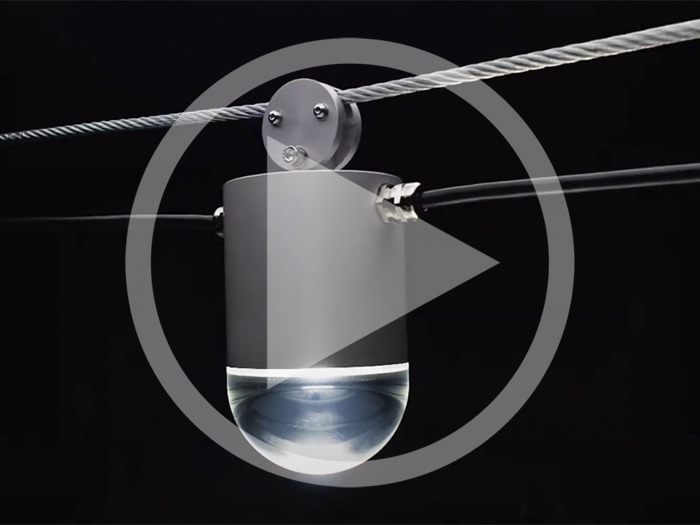
G-Cat is a versatile, decorative yet functional, wire-mounted IP-66 rated downlighter. It can be mounted to catenary wires using a locking hinge mechanism or via a direct single suspension. It’s compatible with multiple control methods and a wide choice of light sources and optics including acrylic fronts or patterned shades.
True to Stoane Lighting’s core ethos of sustainability. The aluminium used is over 90% recycled. The acrylic is virgin (for optical purity and longevity without yellowing) but 100% recyclable. Parts can easily be disassembled allowing for circularity in G-Cat’s life cycle.
Light installation send out signal for UN’s Orange the World campaign
(Austria) – Installation draws attention to International Day Against Violence Against Women.
The Hissisau Women’s Museum, in collaboration with female mayors across the Austrian region of Vorarlberg, has taken part in the UN campaign Orange the World with a unique lighting installation.
Every third woman worldwide is affected by violence, and in Austria, every fifth woman from the age of 16 experiences psychological, physical and/or sexual violence. The Hittisau Women’s Museum and Vorarlberg mayors hoped to set an example against this.
From 25 November – International Day Against Violence Against Women – 24 orange warning lights, arranged in a circle, will flash in the window of the Women’s Museum. The installation, entitled O, was developed with artist Wolfgang Schwarzmann, and is intended to draw attention to the topic with its radiance and call for discussion. For 16 days, the lights will send their signal outside, contributing to the Orange the World campaign.
Despite the museum being closed amid a nationwide lockdown in Austria, the installation is a means of the museum promoting its values and mission to its community.
Supported by the six mayors of Vorarlberg – Andrea Kaufmann (Dornbirn), Alexandra Martin (Raggal), Angelika Schwarmann (Alberschwende), Bianca Moosbrugger-Petter (Reuthe), Carmen Steurer (Lingenau) and Katharina Wöß-Krall (Rankweil), and by the mayor of Hittisau, Gerhard Beer.
Working with Wolfgang Schwarzmann, the installation was created and installed in just three days.
Illuminated River launches virtual exhibition in partnership with Art UK
(UK) – Virtual exhibition curated by Illuminated River artist Leo Villareal
Illuminated River has partnered with Art UK to produce virtual exhibition The Thames Bridges in Light and Colour.
Illuminated River artist Leo Villareal joins a long tradition of artists who have been inspired by the Thames and its bridges – his light compositions mimic the ever-changing movement of the river, using shifting hues drawn from the London sky during sunset, through nightfall and under moonlight.
In this exhibition, Villareal selects paintings of the next bridges to be illuminated, from artists whose approach to light and colour has resonance with his own. Featuring pieces by Canaletto, Monet and Whistler, to contemporary artists like Frank Bowling.
Speaking of Alfred Daniels’ Parliament and Lambeth Palace, London, Leo Villareal said: “We are up height at an interesting eye level that the artist could not have physically experienced in this stylised painting. The precise geometric strokes that mark Lambeth Bridge in red correspond nicely to the iconic double-decker buses. All of this occurs within a generally muted and pastel environment. Westminster and its surroundings are painstakingly rendered. I am most interested in the water and the way the currents are depicted by arching forms. The reflection of the bridge is fascinating in its brown and almost pointillist strokes.”
The exhibition can be viewed on the ArtUK website here.
Illuminated River is a free public artwork transforming the Thames at night. Site-specific lighting artworks have been installed on the river’s central bridges in the longest public art project in the world. Light installations are currently visible on the first four bridges – London, Cannon Street, Southwark and Millennium.
LEDforum.20 shares highlights from digital conference
(Brazil) – Online conference welcomed 600 global attendees.
As with several lighting conferences around the world, Brazil’s LEDforum was transformed into a digital event this year. The resulting LEDforum.20 was held on 6th November, welcoming more than 600 attendees from around the world.
During the online conference, LEDforum.20 hosted eight speakers, who each presented current and industry relevant topics, related to their research, case studies and light art.
Opening the event was Pascal Chautard, whose presentation A Single Gesture revealed details of his award-winning lighting project for the sculpture Su Vertical Nos Retiene.
Case studies were also presented by German architect and engineer Thomas Schielke, who discussed the evolution and inspiration behind the design concept of Apple stores around the world.
Amongst the more technical lectures, Brazilian researcher and educator Mariana G. Figueiro presented results from her recent research on the impact of light during the Covid-19 pandemic. Elsewhere, Brazilian architect and lighting designer Mariana Novaes, together with engineer and researcher Vicente Scopacasa, presented What About Flicker, where they highlighted the phenomena that can be produced by LED light sources.
Meanwhile, Brazilian architect and lighting designer Fernanda Carvalho shared her knowledge and admiration for the works of American artist Dan Flavin, the subject of her Master’s theses. The American artist and educator Chris Fraser also shared moments of pure emotion with his amazing site-specific installations, presented in the lecture Luminous Bodies.
The event concluded with a keynote presentation from Fisher Marantz Stone’s Charles Stone, who presented The Light Outside: Vast and Intimate, part of his series of lectures on post-pandemic outdoor lighting design.
The LEDforum.20 was preceded by digital workshops held in partnership by AsBAI and LEDforum. The Sunrise & Sunset sessions took place on 3-4 November, and addressed themes related to literature, scenography, painting and cinema. In addition, the seventh edition of the International Light Week Workshop (WISL) adapted its format to the current situation, being transformed into an online course. As such, the workshop Lighting for Historical Buildings, given by Prof. Jan Blieske, kicked off on 5 November, and will last for 10 months, culminating in the presentation of its results at LEDforum.21.
LEDforum.20 closed with a friendly invitation from speakers who are confirmed for the 2021 edition, including lighting designers Rafael Leão, Ricardo Hofstadter, Prof. Jan Blieske, Mary-Anne Kyriakou and Wim aan de Stegge; British artist Liz West, and award-winning Dutch artist and architect Daan Roosegaarde as keynote speaker.
Registration for LEDforum.21 is open, and space is limited, as 80% of tickets have already been allocated.
IALD Enlighten Europe 2020 draws more than 500 attendees
(Europe) – Conference moved online due to Covid-19 pandemic
The first ever digital IALD Enlighten Europe conference, held online on 18-19 November, welcomed more than 500 lighting professionals – including designers, architects, students, educators, manufacturers and suppliers – from around the world.
The event, originally scheduled to take place in Oslo, Norway, was moved online because of the Covid-19 pandemic, but representatives from the IALD are delighted with the resulting digital event.
“While we all wish we could be together in person, our online Enlighten conferences still give us the opportunity to gather together as a global community,” said IALD President Douglas Leonard. “This year’s Enlighten Europe showcased a strong line up of lighting luminaries from all over the world. The topics were engaging and forward-focused, reminding us that lighting design is an ever-evolving profession, and our passion for the study of light and its applications.”
IALD CEO Marsha Turner added: “2020 has been a year of many ‘firsts’ for the IALD. And bringing our Enlighten conferences online this year has been another first for us. In addition to the strong educational content, our Enlighten events are for connecting and reconnecting – to catch up with long-time friends, meet new colleagues, be inspired and have a bit of fun. As a result, we created interactive events that focused on connecting and networking virtually.”
The conference opened with a leading international panel on How Have You Adapted and Remained Inspired Throughout Your Career by this Ever-Changing Field of Lighting Design? In this session, Kaoru Mende, Claudia Paz and Kai Piippo shared stories from their lighting design careers, revealing the moments, people and principles that have inspired them throughout their careers.
The topic of lighting for darkness was a prevalent theme during the conference, as Helga Iselin Wåseth from the University of South Eastern Norway and Darío Nuñez of Verkis each held presentations on the mindful application of light, and not trying to eradicate darkness.
Elsewhere, Enlighten Europe offered more thought-provoking content on What Inspires You and How is it Different Now than When You First Started Lighting Design? Here, lighting designers Gustavo Avilés, Mônica Luz Lobo and Andreas Schulz shared their inner thoughts and wisdom about inspiration during the events closing session. From mindful observations and finding meaning from the things around us, to discovering the inspiration from people and the stories behind projects, and unleashing creativity through founding your own company, each designer shared their path to inspiration.
The IALD hope to resume physical conferences with IALD Enlighten Americas, scheduled to take place in Banff, Canada in October 2021.
[d]arc night 2019 highlights
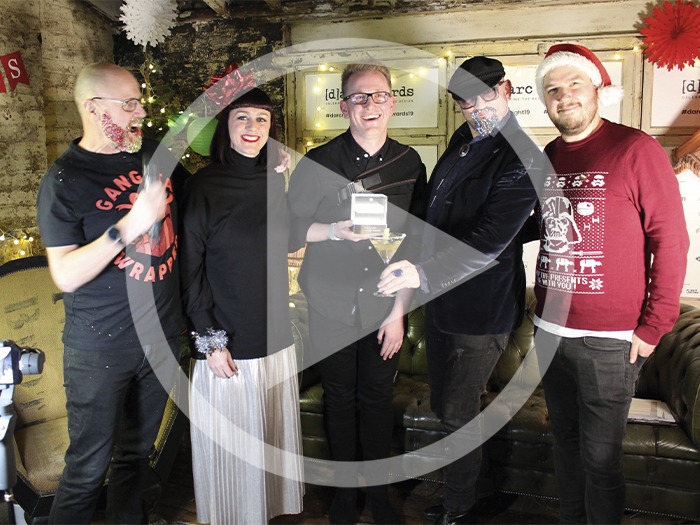
A year on from the 2019 [d]arc awards party, [d]arc night, we look back at some highlights from the evening, including all of the 2019 [d]arc awards winners, and some special prizes for the best installation, and best dressed attendees.
Entries for the 2020 [d]arc awards are still open. All information about the awards and how to enter can be found at the [d]arc awards website.
Video courtesy of Light Collective.
LEDucation rescheduled to August 2021
(USA) – In-person event moved to August, virtual conference still slated for 16-17 March.
Due to the continuing uncertainty of the Covid-19 pandemic, along with New York State and City restrictions on assemble, the LEDucation committee has announced that the in-person 2021 LEDucation trade show and conference will be rescheduled to 17-18 August.
The in-person event is slated to be held at the New York Hilton Midtown, and will continue to include multiple exhibition halls featuring a broad scope of manufacturers and suppliers from across the industry, as well as a dynamic conference programme.
“In a post-Covid-19 environment, LEDucation will continue to prioritise the health and safety of all attendees and will be run in accordance with official government and local authority guidance, as well as New York Hilton Midtown health protocols. This will include enhanced cleaning, non-contact registration, physical distancing, on-site medical staff, personal protective equipment, screening measures, and adapted conference rooms and sessions,” a statement from the event organisers read.
“LEDucation remains committed to keeping the lighting industry connected and will include a virtual component across multiple channels during the August show. Additional information will be available in the coming months.”
Originally scheduled to take place on 16-17 March, a virtual LEDucation conference will still take place on these dates, offering a variety of accredited webinars, all with a focus on solid-state lighting. A virtual online marketplace will also begin on 16 March that will enable registered attendees to review the latest products and technologies from exhibitors, free of charge.
Stoane Lighting launches ReNew division
(UK) – Division established to help deal with increased interest in repair or upgrade requirements.
As part of a concerted effort to be more sustainable, Scottish manufacturer Stoane Lighting has introduced ReNew, a new division that has been set up to help deal with increased interest in repair or upgrade requirements.
“Our focus for a long time, as a manufacturer, has been our impact on the environment,” the manufacturer states. “Since day one, we have believed that a product should be built to last. We continue the same ethos today and are developing product ranges with the Circular Economy front and centre – nearly all kit sporting a five-year warranty and further 20-year duty of care.”
Through the ReNew service, Stoane Lighting provides general repair, deep cleans and electrical safety checks on luminaires, as well as possible repainting, if needed. The division will also replace components that are nearing end of life, such as drivers and LEDs, and will also provide efficacy improvements in LEDs, drivers and optics. If the fittings are to be used in a new area, or the existing space is undergoing a change in use, ReNew can offer a different mounting method or light technical performance (such as colour tuning), if needed, alongside the addition of on-board wireless control.
Once fittings have been repaired or upgraded through ReNew, they will start a new five-year warranty period, and any unwanted parts will be recycled.
“The current global situation has helped us learn some valuable lessons on how we can do things better, ReNew is just one,” Stoane Lighting added. “We’ve opened ourselves up to scrutiny, looking at our standards of social and environmental performance, transparency and accountability. We have helped bring into being an open forum on the subject, welcoming input and questions from all corners of the industry, with the intention of learning and accelerating progress towards a Circular Economy.”
This open forum, the GreenLight Alliance, is due to go live shortly, and will act as an informal CIC intending to move the topic forward. Through this, Stoane Lighting has been working to arrive at a robust set of metrics and guidance to incorporate all aspects (raw components and luminaires, through to specification and deployment) within the Circular Economy. More information can be found at www.greenlight-alliance.com.
Stoane Lighting has also released a detailed paper, showing how its ZTA range has been designed with the Circular Economy in mind. This is available to view on the Stoane Lighting website here.
Light Collective: The Perfect Light Project
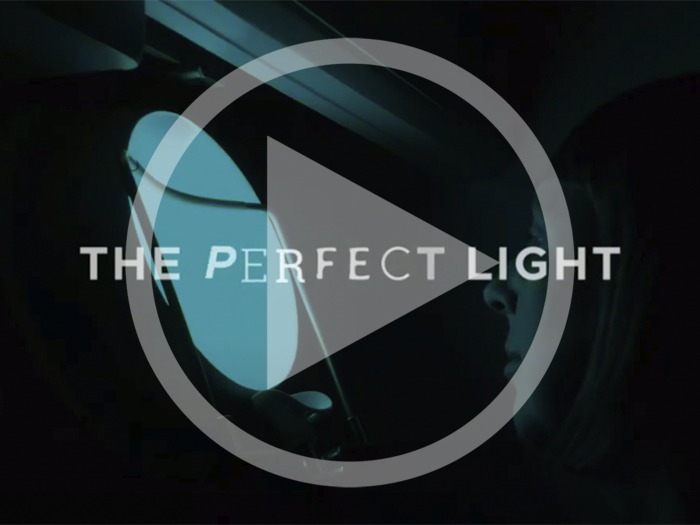
A film by Light Collective: “Is LED the Perfect Light Source? About 3.5 years ago we realised that 90% of our lighting design projects had moved to LED’s as the main source of electric light. Unlike any light source development before, LEDs have superseded and replaced most other sources and potentially rendered them obsolete. We decided to ask a number of lighting designers if LED was, therefore, the Perfect Light? Were we in the middle of the greatest revolution since the invention of the light bulb?
“We finished the film about 3 years ago and showed it first in London, Paris, Berlin, New York and Milan. It has since been shown in 16 other countries at private events. We have decided to put the film on-line now and ask the question – what has changed? Have things moved on in the last 3.5 years and LED has started to become the dominant source in our homes as well as commercial lighting. Do you think LED has improved or has it stagnated, is LED the perfect light source and what do you want to see in the future? Please share this film with your friends and colleagues – we want the debate to be all inclusive.”


